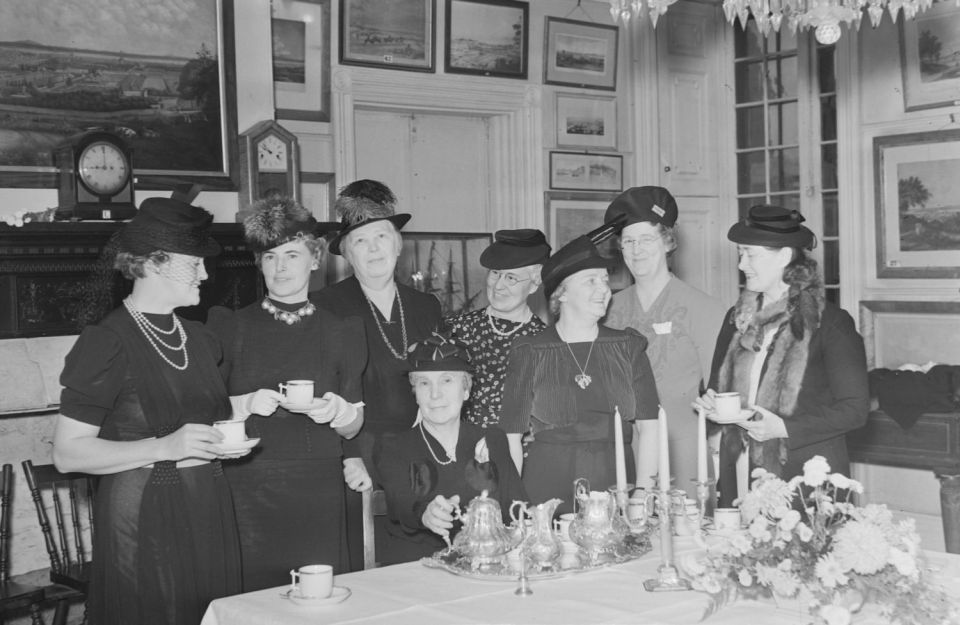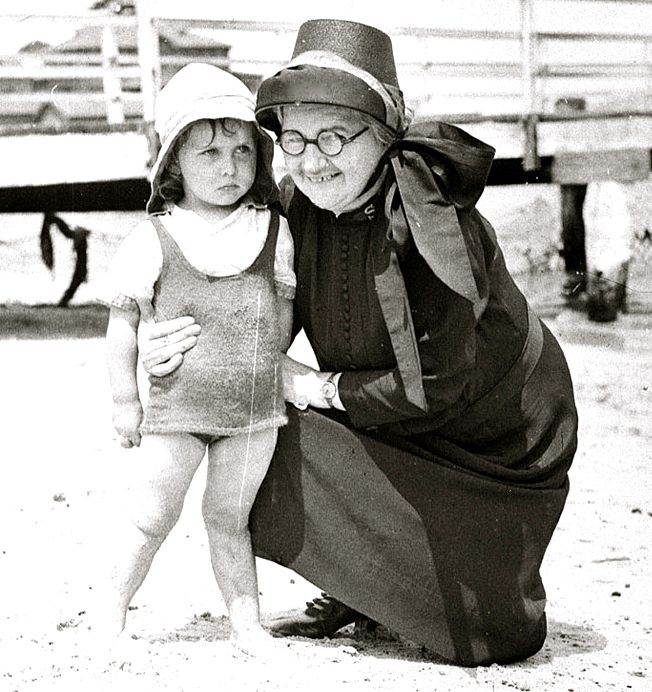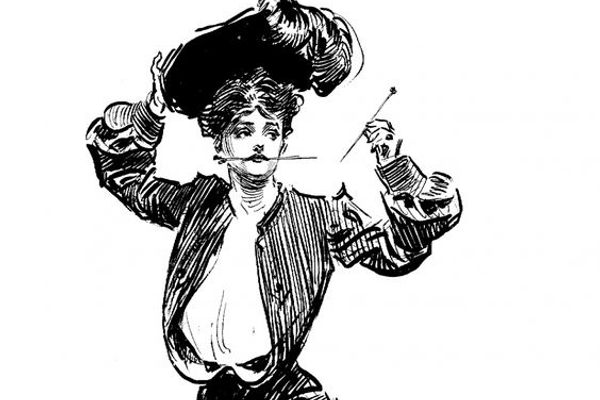When Going Out Without a Hat Was Grounds for Scandal
Back in the day, women with bare heads may as well have been naked.

Can’t live with a hat, can’t live without one. (Photo: Everett Collection/shutterstock.com)
For certain women of a certain time not all that long ago, appearing in public without a hat was an act of brazen impropriety.
In her memoirs, Spanish artist and exile Concha (Conception) Mendez writes about trying to leave the house during the late 1920s with a naked head. If she didn’t wear a hat, her mother said, people were going to get so mad that they’d throw rocks. Mendez responded that if so, she would take the rocks and use them to build a monument in her own honor.
Mendez’s mother was jesting, but at that time, in the 1920s and 30s and up through the first half of the 20th century, Western women of the middle and upper classes were expected to keep the tops of their heads hidden.

Amish women at the beach in 2006, heads dutifully covered. (Photo: Pasteur/CC BY-SA 3.0)
The required covering of one’s head, of course, was not a 20th-century invention. Going all the way back to the Bible, 1 Corinthians 11:6 states: “For if a wife will not cover her head, then she should cut her hair short. But since it is disgraceful for a wife to cut off her hair or shave her head, let her cover her head.” In Orthodox Judaism, married women are expected to cover their heads with a wig, snood, scarf, or hat. In conservative Muslim countries, the dress code carries the expectation of female head coverage, though interestingly, the Qu’ran doesn’t actually require it.
Though hats have also been a historical component of male etiquette, they are often more a self-regulated suggestion than a cultural or religious rule. Delving back into the Bible, 1 Corinthians 11:4 says “[e]very man who prays or prophesies with his head covered dishonors his head.” When it comes to how to present your head, there sure seems to be a double standard.

Members of a Russian Orthodox Old-Rite Church. (Photo: I/CC BY-SA 3.0)
There can be a fine line between reverence and respect, acquiescence and submission, especially when the rules across gender aren’t consistently written. For a growing number of Western women, beginning in the 1920s and continuing up until the 1960s, a hat or head covering felt like a symbol of control and regulation—a symbol of the rules created by men governing the bodies of women.
Concha Mendez belonged to a group of women that has since been called Las Sinsombreros, or “Women Without Hats.” In Mendez’s memoir, she writes of how her colleague, painter Maruja Mallo, declared that they’d had enough of hats. If they had to wear hats, said Mallo, they would carry around balloons, and the balloons would wear the hats instead. If people came to say hi and tipped their hat, the women would tip the hat of the balloon.

Not a gathering of Las Sinsombreros, but of a “Catholic Women’s Club” in 1940. (Photo: Conrad Poirier/Public Domain)
These women’s bodies were very regulated, says Nagore Sedano, a native Spaniard and PhD candidate at the University of Oregon. Whenever they went from a domestic space into a public one, they had to put on a hat. For Las Sinsombreros, not wearing a hat was a way to mark identity—a transgressive statement in their push to be archetypes for the new modern woman.
Though both were members of the “Generation of ’27,” an influential group of poets from Spain and the Basque region, Mendez, Mallo, and their pioneering feminism have been largely forgotten. Sedano says only now are they being written into the history. “It’s kind of sad—in the ’20s and ’30s, these women had more attention than they did in the 90s,” says Sedano. “They really were a part of that artistic scene. People wrote about them at that time, and they were icons … but historians and people involved in this favor men in their stories.” Both a book and documentary about Las Sinsombreros, by Tania Balló, have come out in the last year, so gradually, Sedano hopes, that will change.

American actress Amelia Bingham wearing hat and veil in 1910. Looks kind of like a jail for your head. (Photo: Bain News Service/Public Domain)
Elsewhere, too, you’ll find stories of women whose hatlessness may as well have been nudity. Michigan-based Gena Conti, who has been making women’s hats for 24 years and has traveled around the world tracking down other milliners, recounts coming across a newspaper story from the 1920s. The story reported how a woman had left her house to put a letter in the postbox at the end of her garden gate, without putting on her hat and gloves. A neighbor spotted her sin sombrero, and scandal ensued.
For middle- and upper-class women well into the ’40s and even ’50s, going hatless could still be a risky business. Betty Von Klemperer, who lived in New York City in the ’40s, once recalled venturing out in public with a bare head, then hurriedly crossing the street to avoid being seen by her father.

A Catholic mass in 1968. Note that only the ladies have their heads covered. (Photo: Mrjgardiner/CC BY-SA 4.0)
But with the late ’50s and early ’60s came a decline in hats. The new obsession with elaborate hairstyles, like the beehive, definitely played a role in pushing hats out, but Conti points to a larger trend in practicality. In the ’40s, during wartime, though women were still almost always wearing hats, the hats got smaller and less extravagant. Women were getting involved in a wider range of professions and increasingly on the go. Skirts were shorter, hair wilder, and hats tossed by the wayside.
Conti remembers being required to wear a lace doily at Catholic school as a girl, but even the Catholic Church changed its rules about women having to wear head coverings in church—eliminating a stipulation in the Code of Canon Law that lasted from 1917 until 1983.
Get this hat off my head, Grandma. I consider it a symbol of repression. (Photo: Sam Hood/Public Domain)
“I think part of it had to do with women not wanting to be told what to do, darnit—not being told whether you have to be respectable, have to do this, do that,” says Conti. “It’s like the statement with burning bras: get rid of a hat, you’re free! Like being on the front bow of the Titanic and the wind blowing in your hair—it was a freedom.”

Four members of the Women Airforce Service Pilots (WASPS) leaving their ship, Pistol Packin’ Mama, bare-headed and ready to go (Photo: U.S. Air Force/Public Domain)
Lately Conti has been busy in the midst of Kentucky Derby season, continuing to hand-sew every hat she creates. But now, Conti points out, her customers can make their own decisions as to whether or not to wear them.
















Follow us on Twitter to get the latest on the world's hidden wonders.
Like us on Facebook to get the latest on the world's hidden wonders.
Follow us on Twitter Like us on Facebook